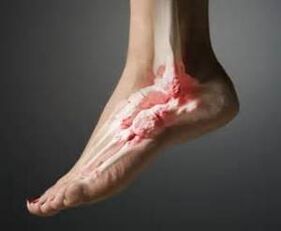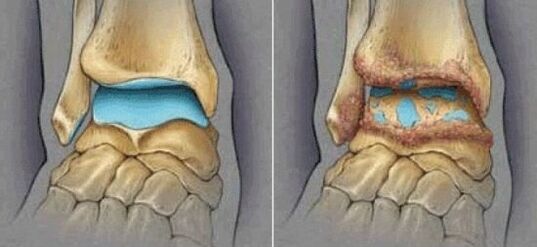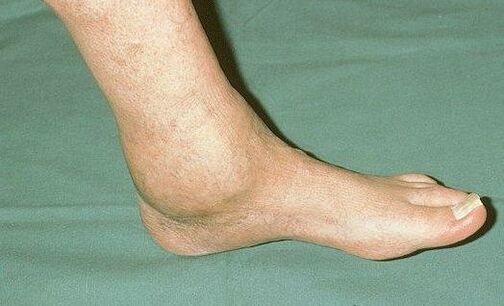
Osteoarthritis is an dystrophic degenerative pathological disease characterized by gradual destruction of cartilage, joints and adjacent bone structures, as well as ligaments and even muscles, leading to impaired mobility and even disability of the patient. The reason for the development of such pathology may be traumatic injury, which develops post-traumatic osteoarthritis of the ankle joint, metabolic disorders in the body or some inflammatory diseases.
Do not self-medicate. At the first signs of illness, see your doctor.
The diagnosis of the pathology is established taking into account the patient's complaints, as well as on the basis of the results of X-ray examination and ultrasound. It is necessary to treat the disease mainly conservatively and only in severe (neglected) cases surgery is indicated.
The disease has a chronic wavy course, in which periods of exacerbation alternate with periods of rest, but still the progression of the pathology, even in the absence of symptoms, continues, therefore over time the ankle is completely destroyed if treatment is not performed. Most often, the elderly suffer from osteoarthritis due to the natural metabolic processes in the body, but there are other reasons for the development of osteoarthritis.
Reasons
There are two types of osteoarthritis in medical practice: primary and secondary. The primary develops as an independent pathology, for no apparent reason. The secondary is the result of any adverse effects, such as traumatic injuries.
The main causes of the disease can be as follows:
- diabetes;
- thyroid disease;
- Overweight;
- permanent microtrauma, which can occur in people who play sports or regularly walk in high heels;
- rheumatic pathologies;
- traumatic injuries in this area (fracture, dislocation);
- inflammatory processes that develop as a result of diseases such as gout, arthritis;
- hereditary metabolic disorders leading to tissue thinning.

Sometimes the disease occurs in children and the reasons for it can be:
- tissue dysplasia;
- congenital anomalies;
- thyrotoxicosis;
- trauma;
- joint inflammatory diseases.
Degrees and symptoms
Osteoarthritis of the ankle has three stages that determine the symptoms of the disease. It is important to remember that the disease develops gradually, so the disorders in the joint will be minor at first, and then more pronounced. At the same time, the changes that have occurred are already irreversible and the treatment of the pathology at one stage or another will consist only in preventing the progression of the disease.
In the first stage of the disease, the tissue becomes thinner and this does not happen on the whole surface, but on individual parts - specific islands are formed.
The disease of the first degree is characterized by the following symptoms:
- excessive fatigue with prolonged strain on the legs;
- joint discomfort after walking on heels;
- mild pain that disappears at rest.
X-ray or ultrasound examination does not reveal pathological changes in the joint, so at this stage doctors can not diagnose.
In the first stage of the disease can be treated at home with folk remedies - in the first place, refuse to wear shoes with heels, lose weight (if necessary), do exercise, and also use some folk methods, which will be discussed moredown.
In the second stage of the pathological process in those areas where the tissue is thinned, the load falls on the underlying bone. As a result, it grows, forming osteophytes that injure healthy areas of cartilage tissue located opposite or near. The symptoms of second-degree osteoarthritis are already more obvious, these are:
- pain with less stress that does not go away as soon as it stops;
- the appearance of night pains that interfere with the quality of sleep;
- limiting joint mobility in the morning (takes some time to take effect);
- joint reaction of time.
In the third degree, deforming arthrosis of the ankle joint develops. During this period, the tissues of the entire joint become thinner, like bone structures, the muscles, on the one hand, are overstrained, and on the other hand, on the other hand, spasm, trying to keep the joint in the correct position. Symptoms of third degree of such pathology as deforming arthrosis of the ankle joint are associated with complete impairment of its mobility and severe pain:
- severe pain that does not stop even at rest;
- in the morning the joint requires long-term development even to make minimal movements;
- crunch sensation;
- the need to take painkillers to relieve pain;
- restriction or even complete impairment of mobility in the affected area.
Pathology such as traumatic osteoarthritis of the ankle joint is characterized by some other symptoms:
- swelling and redness in the affected area;
- local temperature rise;
- crunching or crepitation.

Diagnosis and treatment
A decisive role in the diagnosis of the disease is given to X-ray examination. However, it is important for the physician to listen to the patient's complaints, which may allow him to diagnose at an early stage when radiographic changes are not visible. In severe cases, the patient is referred for CT or MRI of the ankle.
The treatment of ankle osteoarthritis depends on the stage of the disease. In the initial stage, it is enough to change your lifestyle and proper exercise regime. At this stage, massage and therapeutic exercises will be useful, which will improve blood circulation. If we talk about treatment with folk remedies that can be used at home, it can reduce pain and relieve inflammation. These folk remedies that anyone can use at home are:
- rubbing olive oil into the affected area in the morning;
- the use of burdock leaves in the form of attachments to the inflamed joint overnight;
- preparation of omanum ointment and rubbing in the affected area twice a day;
- taking mummy inside in the form of tablets and rubbing into the affected joint.
There are other alternative treatments, but it is important to remember that they are not a panacea for the disease and that only their complex use together with drug therapy, diet, exercise and proper lifestyle will stop the progression of destruction.
If we talk about the treatment of osteoarthritis of the ankle joint with drugs, it consists in the use of anti-inflammatory and analgesic drugs. In addition, patients are prescribed chondroprotectors that protect the joint for a long time (at least six months).
The use of vascular drugs such as niacin has been shown to improve the nutrition of the affected joint. Hyaluronic acid therapy is considered effective and in some cases a single administration of hormones is required.
It is also necessary to treat the disease in combination with physiotherapy methods. Special exercises for osteoarthritis of the ankle are shown, which in each case are selected by a physiotherapist. It is very important that gymnastics with osteoarthritis of the ankle joint does not cause pain to the patient, but at the same time the person should experience some discomfort, as otherwise the procedure will be ineffective.
Other physiotherapeutic methods include:
- magnetic therapy;
- laser therapy;
- phonophoresis;
- thermal procedures and some other types of exposure.
Surgery for this disease is indicated only in severe cases when the joint is completely destroyed. Patients often have joint prostheses that restore the mobility of their limbs, but other surgical techniques are used - the doctor makes the choice, taking into account the patient's condition.

























